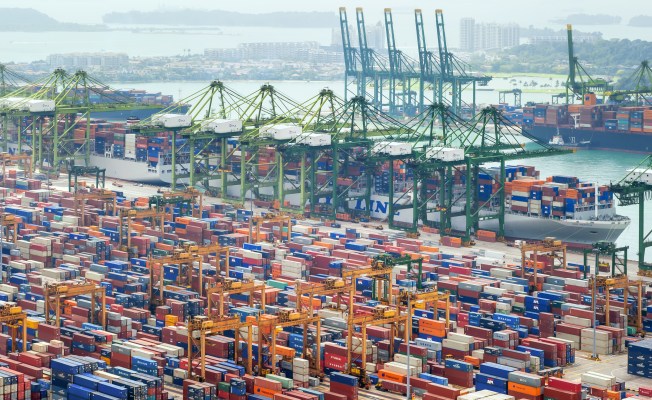Editor’s note: Roei Ganzarski is the CEO of BoldIQ, an operations optimization software company for aviation, ground transportation and staffing.
Eight weeks is what the port of Oakland estimated it would take to recover from the paralyzing effects of the west coast port labor disputes. As much as eight weeks of delays for domestic car manufacturers to receive parts, grocery stores to receive food and retailers to get their hands on the new Apple Watches. And eight weeks for the U.S. exporters to get their goods to market overseas – at least those goods that will not have lost precious shelf life in this period of time.
With West Coast ports handling roughly a quarter of U.S. international trade valued at $1 trillion annually, the cargo backlog at its 29 ports is monumental. Associated Press recently noted that if you stacked all the backlogged containers from the ports of Los Angeles and Long Beach alone, they would rise to more than 300 miles, higher than the orbit of the International Space Station.
Did the port backlogs really have to reach this excessive level, or is it just a part of doing business when importing and exporting by sea freight? In today’s world of big data and advanced analytics, why can’t the ports have systems in place to recover more quickly from these types of events? Or better yet, how can they be poised to minimize the backlogs to begin with if we are to assume that disruptive events like the port slowdown can and will happen again?
The recent crisis is not an isolated event — there have been disruptions in the past and there will be again – whether from labor disputes, political strife or catastrophic weather conditions.
The ports cannot expect an improved result by waiting for the next disruption to occur and again try to figure out how to recover in the midst of a crisis. Ports must re-examine the overall philosophy that governs their entire operation, so when they are faced with the next disruption, they can recover far more quickly and the impact will be minimized.
Right now ports operate with various degrees of computer-assisted decision-making. Where it exists, like in staffing, container planning or berth scheduling, it provides more of a planning aid.
Systems such as these certainly offer a degree of efficiency. But they largely still rely on human intuition, offer little to no insight into how decisions impact the port as a whole, and don’t provide a level of planning and solutions that exceed the operators’ own planning capability. The vulnerability of this philosophy is dramatically heightened whenever there is a disruption because the port is trying to react to a disruptive situation in an already non-optimized operating environment.
To overcome and preempt this damaging ripple effect, ports need to deploy an operations philosophy that accounts for and takes advantage of the entire sum of their parts. Within a very complex and unpredictable environment, ports need to know that they are maximizing each and every resource within a port for their own benefit and the benefit of their customers. And they need to be able to adjust rapidly to any change or disruption they face.
Ports should not have to question whether resources are in the most optimal location to minimize wait-times, cost and maximize the efficient transport of goods. Once ports accept a holistic view of operations management, they can then look at the technologies available today to realize their full potential.
So ports may wonder, what does an optimized port system look like? Do the technologies even exist to provide real-time dynamic operations optimization? The ports don’t need to look any further than the aviation industry.
Take private jet company JetSuite. Built by one of the founders of JetBlue, JetSuite’s business model of affordable, on-demand air travel depends on a holistic operations philosophy. The company has figured out how to maximize its resources relative to the needs of the entire airline rather than just its individual parts.
Like the ports, JetSuite must operate within a highly regulated, complex and unpredictable environment, managing factors such as fluctuating customer demand, regulatory and operational constraints, resource maintenance, changing fuel prices, staffing schedules, and of course unpredictable weather.
But unlike the ports, JetSuite deploys a technology to manage all of its resources in a dynamic real-time fashion. Despite daily changes and disruptions and fierce competition among more established airlines, the young airline has risen to fourth in total revenue hours flown and second in aircraft utilization among its peers.
Similar systems have been deployed for transportation, drones and staffing management, which have realized as much as 16 percent reductions in operating costs and 20 percent increases in capacity using only existing resources. These industries have begun to realize the value of operations-focused advanced technologies.
Our ports can realize this value, too. They can increase throughput of their ports without investing in capital or trying to enlarge their geographic footprint. And they can diminish the damage done to global trade by such a labor dispute.
Instead of taking eight weeks to recover, what if the port only took four? This is attainable with the technologies we have today. This kind of operations optimization could make a difference of millions, if not billions, of dollars. Beyond the pure dollar impact, harnessing this type of technology will help ensure the longevity of importers and exporters and the economy as a whole.
Just as any other dynamic industry, the ports have very little control of when or what disruptions will happen in the future. But they do have the ability to transform the way they run their operations and how to best optimize resources so that every disruption recovery is far faster, less costly and, as a result, less burdensome on our economy.
